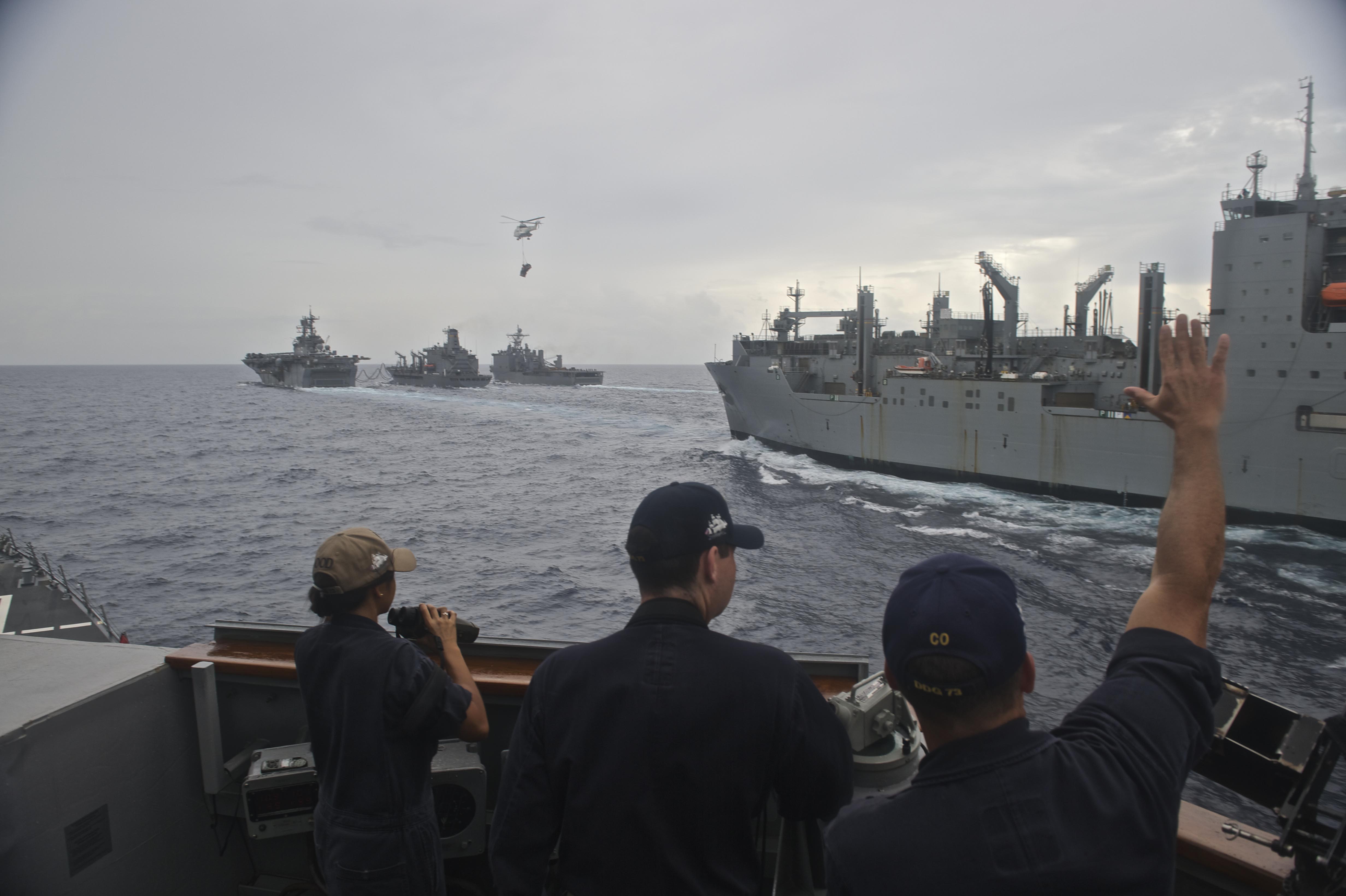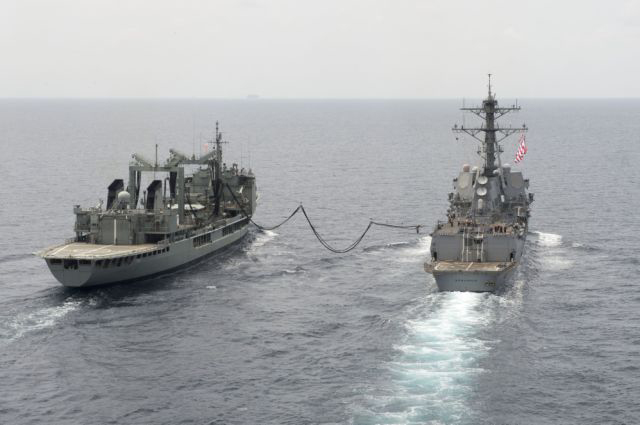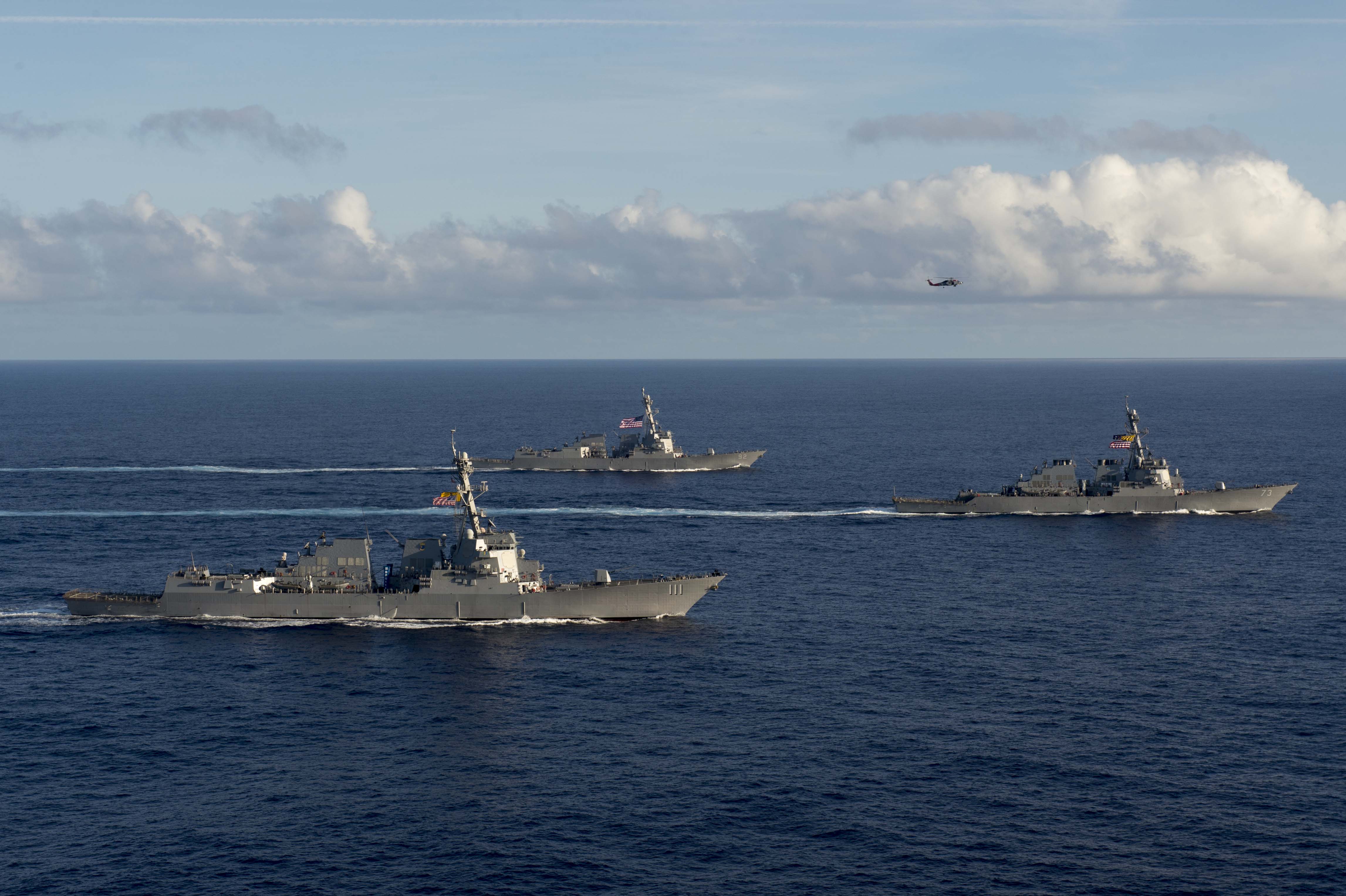
The Navy will take lessons learned from the 2016 deployment of a three-destroyer Pacific Fleet Surface Action Group (PAC SAG) that remained under U.S. 3rd Fleet command and stretch itself further, deploying a full carrier strike group under 3rd Fleet command and potentially forming a multinational “PAC SAG 2” this summer.
3rd Fleet Chief of Staff Capt. John Beaver said last week at the annual Surface Navy Association conference that last year’s deployment of USS Momsen (DDG-92), USS Spruance (DDG-111) and USS Decatur (DDG-73) was a good first step in learning how to project power outside the carrier strike group concept and in creating alternate command and control (C2) relationships.
“I would say that what we’re doing is we’re experimenting with different command and control arrangements and different force relationships to be able to get the maximum amount of lethality – so back to distributed lethality, we want to present a problem to a potential adversary beyond their ability to solve, so that’s what we’re experimenting with,” he told USNI News after moderating a panel discussion on the PAC SAG deployment. Distributed lethality is the Navy’s concept that a U.S. force that is geographically dispersed, but where every ship carries a lethal loadout of weapons, severely limits an adversary’s options.
“There is a hardware component to distributed lethality. There is also a [command and control] component,” Beaver said during the panel.
His panelists – the destroyer squadron commander and three destroyer commanding officers involved in last year’s PAC SAG – said the deployment went smoothly on their level, though they relied heavily on international partners for support. For example, without an oiler or supply ship attached to their group, as might be the case with an aircraft carrier, the destroyers often refueled from allies’ oilers, primarily from the Australian navy. They also were told at one point to order food and supplies from the Australian Navy logistics organization.
“It was a PACFLT initiative, the PACFLT supply officer wanted us as we were operating forward to be able to order from kangaroo meat, whatever, all those wonderful things that the Australian Navy has in their supply organization, Destroyer Squadron 31 commodore Capt. Charles Johnson said during the discussion.
“How do we order from them? That was one of the failures, but we got into that and the supply folks are figuring it out now.”

The ship COs said the refueling details were worked out at the DESRON level but that they refueled from a variety of nontraditional sources at sea and pierside and that they also tried out some nontraditional methods of saving fuel to put less strain on the situation.
The three officers – Cmdr. Garrett Miller, who commanded Decatur during the PAC SAG; Cmdr. Manny Hernandez, who commanded Spruance, and Momsen CO Cmdr. Jason Kipp – also described some harrowing casualty evacuation situations they faced without the help of an aircraft carrier’s medical capability. In one situation, a sailor from Decatur experienced a “significant medical emergency,” and being a ballistic missile defense destroyer the ship did not have any helicopters onboard. The ship had to call in a South Korean helicopter to bring the sailor to a hospital, since Momsen and Spruance and their helicopters were too far away and steaming to the closest port would take too long, Miller said in the panel discussion.
Though the idea for an international PAC SAG 2 did not come as a result of the first PAC SAG’s reliance on allies’ and partners’ support, these examples bring a new importance to the potential international collaboration this summer.

Beaver told USNI News that the PAC SAG participated in the Rim of the Pacific 2016 exercise in Hawaii over the summer, and “we had a tremendous response from our partners all around the Pacific Rim during the RIMPAC exercise, there was a lot of back and forth. So from a naval force level, we thought there was a great deal of interest in doing that (multinational PAC SAG 2). Now we understand that ultimately those are policy decisions, and so those navies have to go back and talk to their civilian leadership and get political direction. But as naval officers talking to other naval officers, they saw great possibilities, so we’ve returned those discussions to capitals and are waiting to hear back from the capitals on whether or not that’s doable.”
He noted during the panel that “there are a lot of issues associated with that that are echelons above the 3rd Fleet Commander” as well, and 3rd Fleet is awaiting instructions for how to move forward as well. A “small slice” of the Carl Vinson Carrier Strike Group, which deployed to the Western Pacific on Jan. 4, stayed behind and would serve as the U.S. contribution to the PAC SAG 2, Beaver said.
Additionally, Beaver said 3rd Fleet stood up a new flag-level organization – Commander, Task Force 30 – to command future “3rd Fleet Forward” deployments, where ships deploying from San Diego remain under 3rd Fleet operational control even after passing the International Date Line, where they’d normally move to 7th Fleet control. The 2016 PAC SAG was the first group to do this, and “It has been awesome because we’ve failed at every turn. It’s been such a rich learning environment. We’ve had communications issues, we’ve had integration issues… [Learning] that’s what this is all about,” U.S. Pacific Fleet Commander Adm. Scott Swift said in November.
Rear Adm. Jim Kilby recently took command of CTF-30, and his first challenge will be overseeing the deployment of the Carl Vinson Carrier Strike Group. CTF-30 will fall between 3rd Fleet and the Carl Vinson CSG commander. Beaver said CTF-30 had existed previously but has not been used in any modern operations. Calling it a “revitalization” of the command, he told USNI News after his panel presentation that “what we’re doing is aligning 3rd Fleet operations with operations in 7th Fleet and 5th Fleet and 6th Fleet.”

Johnson, the DESRON commander, said the first PAC SAG was “at the CO level, at my staff level and below, seamless. There were no command and control questions. Obviously there were machinations above, and that’s great, and that’s what the learning process was for. But below at the operations, day to day events, there were no issues anywhere across the board.”
To address those higher-level operations, Beaver said in the panel discussion that “we had a command and control element that made the difference, they were focused on the SAG – it wasn’t an add-do responsibility for the 3rd Fleet N3 (operations) shop, it wasn’t an add-do responsibility for the deployed strike group, for the strike group (operations) shop. This was a dedicated commander unifying the efforts of three ships and communicating effectively up, down and across. … It was the ability to plan and it was the command and control – it’s that additional echelon that I think, on initial analysis, made it better. And so as CTF-30 stands up, we now have a flag staff doing this as opposed to a DESRON staff, and so we’re anticipating a commensurate improvement in that level as well.”
PACFLT, 7th Fleet and 3rd Fleet are now in discussions about how to allocate resources in the theater between the two numbered fleet’s operational assets, but he said the logistics professionals in CTF 33 under 3rd Fleet and CTF 73 under 7th Fleet collaborated well during the PAC SAG deployment and praised CTF 73 as “a national treasure in Singapore.”





